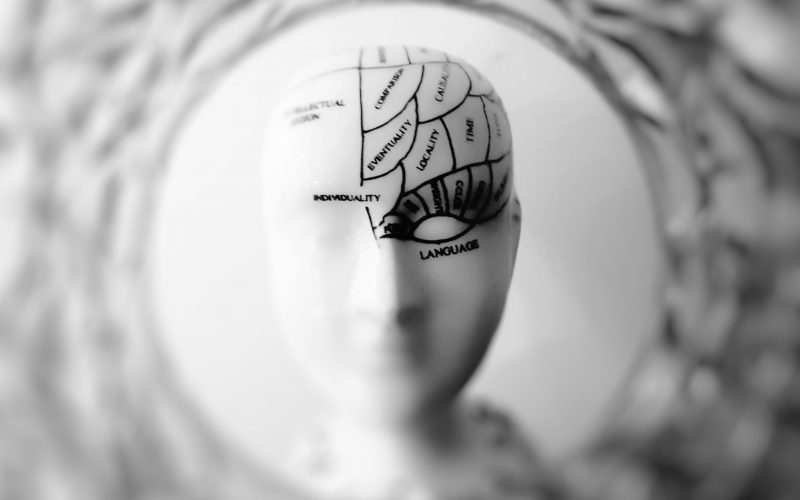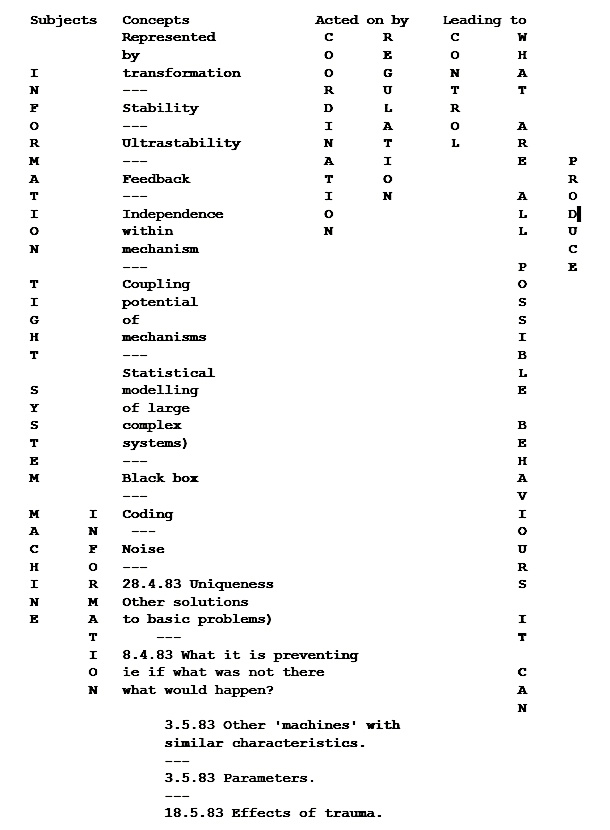
When I started studying Cybernetics, in 1982, we were asked to read ‘Introduction to cybernetics.’ (Ashby 1956). After sleeping on the first three pages I produced the following chart:

Cybernetics processes to apply to information tight systems/machines developed from the ideas in the introduction of ‘Introduction to cybernetics.’ (Ashby 1956 from Hibbs 1992)
I noted that Ashby suggested that by working out a cybernetic example of ‘all possible uses’, one may identify important information gaps.
This was something that I could get my head around at this early stage, so I decided to explore it. I first chose a ball-point pen to analyse, but soon abandoned that as being too complex. A lead pencil seemed more promising.
I started with iterations of a spider graph and before long would have needed paper the size of my room to put all the possibilities.
The analyses included attempting to use the concepts from the chart above. I decided that ‘represented by’ might be some form of transformation or substitution, in which the wood might become charcoal and the paint molten paint drops. I noted that there are many possibilities for using the whole or parts for unusual purposes: mini building blocks, cogwheels, wedges, dice …
When I started to think about the ‘lead’ I quickly realised that it was not the metal, lead, but graphite! My research showed me that graphite is active with very strong oxidisers like fluorine, chlorine. Because except in a vacuum where its layers are not so slippery, it is the ‘universal lubricant’, excellent for door locks because it does not become sticky. Usefully it is stable to minor trauma, but abraded and transferred to surfaces that are not microscopically smooth, like paper. So, that explains why it does not work if there is grease or oil on the surface.
I found no ideas for ‘ultrastability’ but some ideas for ‘feedback’ by observing written marks, hearing it crack or feeling or seeing it break. Then I decided that a database of feedback mechanisms might be useful in future and suggested that the new Exercise Physiology Department (now part of Brunel University) would have useful components for such a database.
In a similar way, I continued to work through the chart.
When I came to the next seminar my supervisor asked about it, “Would anyone else be able to follow the paths that you have taken?” I said, “In theory, yes, but many of the databases have yet to be built.” He said “Fine. Leave that now and learn Cybernetics.” In the appendix A of my thesis, I provided instructions to follow my thinking.
So, what is the question that you should ask? — ‘What are all possible uses?’, rather than the usual one, ‘What else could I use it for?’.
If you think about it, lots of things that we do are reusable with modifications, but most of us treat a lot of what we do as single use, not thinking that one might be able to use them to leap-frog on another occasion. Storing whole entities or single components in retrievable form with a suitable address, could save hours of work.
Those of us in innovation too often ‘miss a trick’ by asking ‘all uses’ rather than ‘all possible uses’, a question that takes your creative brain forward to exciting reverie and possibly some great ‘aha’s’ in the hours, days, weeks that follow.
My thesis is: Information handling: concepts which emerged in practical situations and are analysed cybernetically. 1992 Accepted for PhD. ISBN 1 873015 03 8. The online version is available for free download here. Full copy at Brunel University and the official deposit libraries including the British Library.

Genevieve M Hibbs former: nurse (general and occupational health), midwife, Christian missionary, lecturer, elected councillor, mayor and a member of the Lucidity Network. To connect with Genevieve and the other wonderful members of the Lucidity Network join our free Lucidity Facebook community for clearer thinking and better results.
